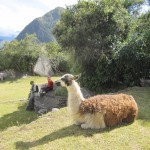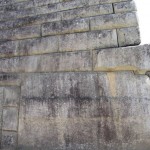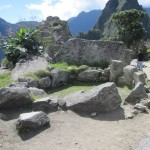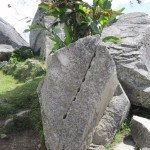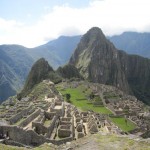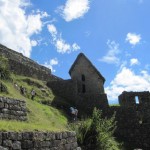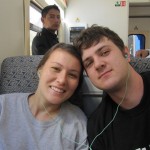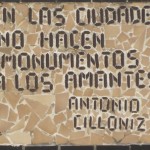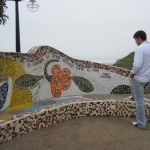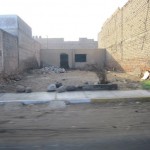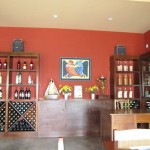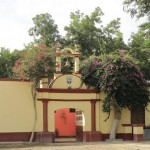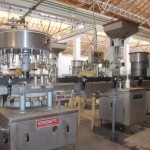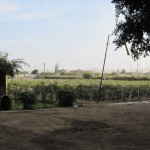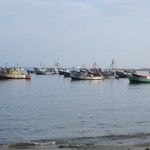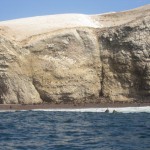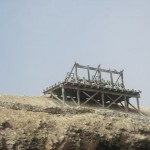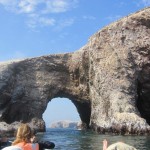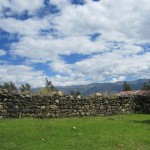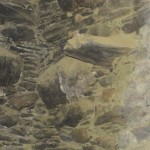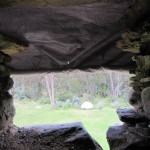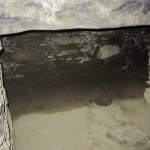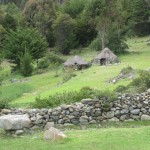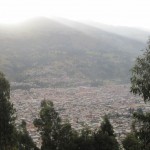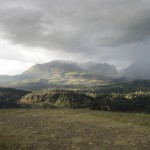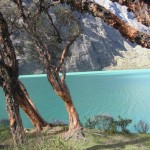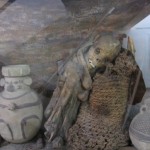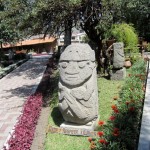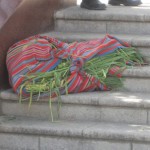May
29
Preliminaries: Apologies for my extended absence! I was locked out of this site for a while (my fault). Also, scratch what I said about extranjeros not actually being interested in the US’ domestic politics; trying to explain the health care debate intelligibly in Spanish is incredibly difficult (probably because it’s also difficult to make sense of in English, but that’s (sort of) a different story).
I spent four days a few weeks ago in Pumanque, a tiny town located about three hours southwest of Santiago and three hours northeast of Constitución (the epicenter of the earthquake), where about 200 engineering students and another exchange student friend and I spent four days constructing mediaguas (emergency shelters) with the organisation Un Techo Para Chile (“A Roof for Chile,” more or less like Habitat for Humanity) for victims of the terremoto. Seventeen more charter buses of USACH students went to six other towns to do the same.
The experience was a lot of fun. I met a lot of new people. I ate a lot of good food (including Gala apples right from the tree! I’d never seen an apple tree before!). I made liberal use of words learned in my Pilates class (like estirar – to stretch, as in “Stretch the measuring tape,” and hundir – to sink, as in, “Oh no, the roof está hundido!” (has a leak)) to communicate with my cuadrilla about the building process. We slept at an internado (military barracks), and I met a few eighteen- and nineteen-year-old soldiers completing their mandatory military service. We all spent a lot of time shivering (winter is coming fast).
I feel like I say this a lot, but the countryside was also beautiful. My new chileno friends tended to give me incredulous looks when I said so, but just because the region’s not Chiloé doesn’t mean it’s not lovely in its own right! Mostly though, I just really enjoyed getting to travel to another part of Chile while making myself useful at the same time, and will definitely go again if I get the chance.
I was also asked no less than four times there, “Don’t Americans speak worse English than the British?” which bothers me on multiple levels. My inner wannabe-linguistics major immediately screams, “But there’s no such thing as a “better” or “worse” language!” Then my experience here makes me remember that I definitely make an exception to that proposition where accent is concerned. There are people I live with who I still have a lot of trouble understanding after two months on account of their accents, and comprehensibility seems to me probably the only reasonable standard for “judging” a language.
And the fact that I’ve only really run into that question from Chileans has a lot to do, too, with how they relate to and think of their language. I spent a lot of time at the internado talking about the language Chileno (as distinct from Español) and its modismos (special vocabulary/idioms). Chileans are very acutely aware that they speak (self-described) “worse” Spanish than say, Peruvians or Mexicans (two nationalities known for their slower, very clear manner of speaking), both in terms of their accent, which is so difficult to understand, and the fact that they make up so many modismos, and from what I can tell their grade school English teachers have been indoctrinating them to think that you can similarly judge English dialects.
(I’ve also clearly found myself being a lot more knee-jerk defensive of my country and most things associated with it than I expected. Anyway, I stand by my position that you can’t judge Standard American against Standard British English in the same way, though I guess comparing regional accents this way would be essentially the same as comparing Spanish accents by country.)
Anyhow, those kinds of questions, as well as giving informal English lessons to my house-mates who are taking English classes, has turned me on to the differences in English dialects, too. For instance, when I look through an English textbook, I can generally tell within a few pages whether it’s written in British or American English, and not just because of the extra ‘u’s. There are more subtle differences in usage, like the use of “mustn’t” or “needn’t” instead of “shouldn’t” or “can’t,” or the fact that, “I’m mad about this blouse,” never means, “I just love this blouse,” in American English. But that’s neither here nor there; just goes to show that wherever you go and whatever you do, you’ll always end up learning most about yourself.
Hm, what else? I’m sick again! (Every two weeks, de nuevo.) Other than that, I’ve been reading reading, for Latin American Lit and because my History of Chile professor found me a few books in English!, since I have essentially zero context for the politics of Chile ca. 1920-70 (on a related note, I can’t imagine how students managed study abroad before the internet).
And today I cleaned my room, went shopping at Líder (Wal-Mart affiliate) and went with some friends to a concert/benefit featuring Chilean folkloric music and dance for Lolol, a little town affected by the earthquake. Came home to find the residence (and its residents) in total chaos since it is, after all, a Friday night. What I mean to say is, my life’s been pretty low-key lately. Not every moment is thrilling and different; routines happen everywhere. Which is not necessarily a bad thing — it just leaves me with less to blog about!
Hasta pronto!
May
27
Wow. I can’t believe my time here in Peru is winding down. I am almost 2/3 of the way done. A little more than 6 weeks to go. That fact evokes a mixture of emotions–as ready as I am to come home, I still feel I have a lot more to accomplish here in Lima. There are still things to be seen, and I would love for my Spanish to get a little better. It has definitely become better, but not quite as much as I would’ve hoped for at this point.
Jon arrived in Lima at 2 am last Friday morning–delayed in Houston. I took a safe taxi Taxi San Borja to and from the airport. You have to call this company well in advance to get a taxi, but late at night–especially since I was alone, it was definitely worth it. The taxista was nice and showed me where to go to pick him up and then waited (for an hour due to customs and baggage claim) for me to return with Jon. He took us to my host stay. We got about 3 hours of sleep and then the same taxista picked us up and took us back to the airport for our flight to Cusco.
Here’s the logistics of our trip:
Friday--Flight to Cusco left around 10, in Cusco around 11. We took Taca airlines. Checked into our hostel, Wasichay in Cusco. It was a great location-and ok room for the price.
Saturday– Our travel agency Andina Travel picked us up at Wasichay at 6:50 am. We took a Perurail bus from Cusco to Piscacucho and then the Peru Rail train from Piscacucho to Aguas Calientes. We arrived in Aguas Calientes around 12:30 in the afternoon, and our hostel Pirwa Hostel (highly recommended by a friend of mine, and I loved it too) picked us up from the train station. Everything in Aguas Calientes is basically within walking distance so we walked to our hostel, left our backpacks, and then walked to the bus station. We took a 20 min bus up to Machu Picchu! and spent the afternoon there (about 3 1/2 hours). We didn’t use a guide–just walked around by ourself. I had a tour book especially for MP, but decided not to use it about 3o min in and just soaked up the beauty instead of figuring out what each rock was haha.
Sunday– We took the 10 am Peru Rail train and were back in Piscacucho at 11:30. Then we took a Peru Rail bus to Ollantambo. Then our travel agency sent a taxi to pick us up from Ollantambo and bring us back to Cusco. We didn’t get back until a little after 3 pm because the towns of Ollantambo and Urubamaba were celebrating a religious festival and the traffic near Urubamba was backed up.
Monday– We took a flight to Lima from Cusco at noon!
This was definitely a whirlwind go-go-go type of trip, but Jon only had 6 days in Peru-so it was necessary. And quite honestly, I felt like we got what we wanted out of the trip–great food, relaxation, and MACHU PICCHU! There was probably a lot in Cusco to see that we didn’t, but I really don’t feel too bad about it……
I would defintely definitely recommend using Andina Travel. And ask for Erick! He speaks English, which is nice when planning a complicated schedule, and he was very quick to respond by email! I booked our flights to Cusco, our Peru Rail train tickets, and our hostel in Aguas Calientes all on my own. Then I sent this information to Erick, and he handled coordinated transit bus/taxi pick ups, our entrances to Machu Picchu, the bus to Machu Picchu, and our hotel in Cusco. As far as I could tell, I payed no extra than what I would’ve for these services had I done it all on my own–agency must get a discount. And it saved us a montón of time and stress. When the agency picked us up from our hostel in Cusco on Saturday morning, the lady had our train tickets, MP bus tickets, and MP entrance tickets all stapled together for each one of us and in a nice brown envelope. Also the only reason we had to do taxi and buses to and from Piscacucho was because of the January mudslide. Normally Peru Rail would take you straight from Cusco to Aguas Calientes, you would take the same bus from AC to MP and be done with it. Apparently Peru Rail has been changing ticket details last minute frequently and having an agency who was used to this and adjusted according was awesome. Plus having the bus and entrance tickets to MP in hand was soooo convenient. No standing in long lines, figuring out where to the ticket offices are, etc.
When back from Cusco/Machu Picchu Jon and I rested/went to a movie– ROBIN HOOD!!!with Russell Crow and Cate Blanchett–so good! Then the next day, we went to Miraflores–Park of Love, beach, another movie DATE NIGHT with Steve Carell and Tina Fey–also good! and dinner at the Rosa Nautica. Then Wed (day he left) just rested and showed him around my neighborhood and took him to the 4 estaciones jugeria for dinner and banana milk (my new fav drink).
All in all it was a successful trip. It was hard to say goodbye again, but I’ll be back in 6 weeks!!! Also the things he brought from home (my sister packed them) are really gonna make my time in Lima better–assorted teas from the candy basket, cinnamon disks, trail mix (goldfish, dried cranberries, mnms, and peanuts), warmer shoes, extra workout shirts, moisturizer, hot chocolate mix, new OU scholars tee, and LuLu (my stuffed bunny)!! My sister is amazing. I love and miss her so much.
I’m going to do a separate post about the food we ate while traveling and in Lima! The food was definitely Jon’s favorite part!!!! And I don’t blame him–we happened upon some great places with great dishes!!!!!
May
16
Weather
The seasons have begun to change here in Lima. It is now fall! When I first arrived, sandals and shorts were the appropriate attire. Now, layers are more efficient. When the sun is out, it’s warm-ish. But there are stretches in the morning and definitely after sunset that are absolutely freezing!! The temperature might be 60, but it feels like 40 or below. And according to some (new!yay!) Peruvian friends and our host family, June will be colder. So…I need to invest in a warmer jacket ( I only packed a light Columbia zip-up jacket) and some more comfortable closed-toe shoes! I don’t want to wear my tennis shoes everyday, and the couple pair of closed-toes I brought give me blisters easily! My boyfriend is coming for a visit (he’ll be here Thursday ahhhh!!!! 🙂 🙂 🙂 ) and I’m going to ask him to bring my boots and also take home some sandals and other summerish clothes that I will no longer be needing. I figure I’ll buy a warmer coat here, because I don’t want my peacoat making a trip to Lima. I would hate for something to happen to it! Besides my Lima winter coat can also serve as a souvenir!
As a result of not initially being prepared, I have a bit of a cold. I went to the pharmacy (boticas–they’re literally everywhere) and told them that I had a headache and a stuffy nose. They gave me a pill called “gripadyn” –not an antibiotic, because I asked– but no idea really what it was, although it did work wonders along with 4-5 pocket packs of kleenex! (Funny side story about the kleenex: I went to a corner store to buy some pocket packs, and I knew the word for kleenexes was “pañuelos”. I had bought “pañuelos” in Mexico and had remembered the word from seeing it on the package. However, I never realized I had only just read it and never said it out loud. So when I asked the lady at the counter for the kleenexes she had no idea what I was talking about. I had to resort to the hand motion of blowing my nose :/ This was followed by a well-intentioned Spanish lesson. She actually had me “repeat after me”. She was like– “pan….repita! pan” ….”ñu”…”el”… “o” and I humored her and repeated 🙂 🙂 I kinda still have trouble saying it, and I think next time I will try saying “Kleenex” with a Castellano accent haha it works with things like oreos :))
Some linguistic tips for fall (in addition to the pañuelo lesson):
resfrío (cold)
gripe (literally flu– but I think here it is like a stomach bug? or sickness in general–b/c often they ask if I have gripe after I describe my cold symptoms…ok maybe this one wasn’t actually a tip, but rather something I’m trying to figure out..)
chompa (jacket)
abrígate! (keep warm or bundle up)
Food
I also found that I have a fish allergy. Kind of weird since fish (both fresh and marine) has never made me sick before. Well, remember how I got sick last Thursday and we didn’t end up going to Cajamarca as a result? We ate fish for lunch that day. Well I chalked my sicknesss up to a motion-related one because everyone ate the same food and I was the only one who got sick. However…. this Saturday we also ate fish for lunch. And sure enough, two hours later I got sick in the same exact way (same headache, acid reflux, vomit-type). I feel the fact that I ate fish both days is enough to consider these episodes noncoincidental… I am also allergic to betadine (contains an Iodine compound–I looked up the word Iodine and it’s “yodo” in Spanish.) From what I’ve been reading, marine fish can have a large amount of iodine or a protein similar to it in their muscles. I don’t really know how I can be unallergic to iodized salt and other iodine-containing foods, but I am allergic to the iodine in the fish….. Maybe different forms of iodine.
Perhaps this is something I will learn in medical school. I’ve tried to search out the answer on the internet (google and such), but the answers are exteremely variable–seeing as how anyone can post their opinion on the web! Well–if anyone reading this can enlighten me–I’d love your input! (Especially Lizz if you’re reading–maybe you can ask Dr. Ryals if he knows!) Also, I’m not sure exactly what kind of fish I ate (only that I ate the same kind both times) –my host family calls it “diamante” or diamond fish.
Time after Midterms
Besides the two relatively short bouts of sickness related to the diamond fish, my time since midterms has been thoroughly enjoyable. I have caught up on blogging, reading, scholarship essay writing, working out, and a little sightseeing!
This past Thursday Calin and I went to the Center of Lima for our first time! Cindy and Serena (two other OU students studying at Católica) were nice enough to take us! We now know which combis to take from school and a little of our way around. We walked through Plaza San Martín and the Plaza de Armas, ate lunch, and went up to the Mirador San Cristobal! It was a great trip. We only stayed a few hours because we had to get back for class, but hopefully we’ll go again soon and get to see more!
Calin and I also went into Wong for our first time. I am so so so excited about my first (good) purchase of turkey meat and cheese for sandwiches. ( My first time was at Metro, and I was very disappointed). Calin and I have also tried out two Mexican restaurants: Mi Carcochito (last post) and Sí Señor. We went to Sí Señor today in Miraflores. I think it was my favorite of the two. It had many more choices and almost all were Mexican (where as at Mi Carcochito the majority was Peruvian, but they offered tacos). I ate tacos de carnita cancun or something along those lines. They were great, great, great flour tortillas with meat, pineapple, onions, peach, beans, and guacomole inside. Calin had enchiladas, which she said were really good.
List of restuarantes to try before I leave is now the following:
–>Rocoto Relleno
–>a cevicheria en Miraflores (which might be tricky now with my aversion to fish)
–>Don Rosalina
–>Como Agua Para Chocolate
–>Limeño Tradiciones
–>La Rosa Nautica ( Hopefully I get to check this one off when Jon comes!)
Midterms
I have yet to get all of my midterm grades, but hopefully I will this week. I did get my “Etnicidad, Identidad y Nación” grade back and it was an A! (which I was proud of because it was an essay test in Spanish). I am still waiting on my “Seguridad Internacional” grade–it was also an essay test–, my “Justicia y Organismos Publicos” ensayo–5-7 page essay in English–, and my Quechua exam…..which practically everyone cheated on (not me-gracias to my morals and OU’s strict academic honesty policy). And the teacher is not going to make us retake it! The teacher was not present at the exam–a proctor was, and everyone whipped out their notes claiming they were “like” dictionaries (b/c dictionaries were allowed, but not recommended). It was one of my most bizarre experiences here. I was livid about the whole situation, and from what I could tell it was not as big of a deal to the professor or the students. The profesora lightly scolded everyone the next class period, but that was that.
Oh well, what’s done is done haha–I need not stew about my Quechua test any longer, and I am so excited for this week! I have four days of class, and then Jon will get here late Thursday night. And we will be off to Cuzco and Machu Picchu for the weekend! I hope that all goes smoothly! Wish us luck! And I will surely be returning with beautiful pictures and memories!
May
12
Let’s talk for a few minutes about the place that is, after all, the reason that I’m in Santiago. Looking back, I guess I expected that it would be mostly like US campuses I’ve visited, minus the extravagant building projects, but I didn’t give the question much thought. Given that lazy preconception, I was really surprised: the school and the students are qualitatively different from their US counterparts in several ways. USACH reminds me, in almost every aspect, of what I imagine (both from movies and from the fact that in the course of my fifteen years of education alone thus far I’ve watched dramatic changes in the level of technology available in the classroom) universities in the US must have been like twenty or thirty years ago. And I mean than in the most complimentary way possible. In fact, it really is a compliment.
Most of the classrooms (certainly in the Facultad de Humanidades, or FAHU; lack of funding for the humanities seems to be a universal problem) are un-air conditioned and un-heated. Some of them are not even fully enclosed. None of them (again, in the FAHU) have installed DLP projectors or computers or video screens or even overheads. No fancy lighting, no padded desk chairs, just the class and the teacher and the white board.
The campus is too open to be described as labyrinthine, but it is huge and certainly difficult to find your way around. None of the buildings with classrooms have names or are otherwise labeled, and there’s no rhyme or reason so far as I’ve seen to the numbering of classrooms. Damned if I can find anything without asking for help.
That being said, I also think it’s beautiful. As a result of being so spread out, there are courtyards and trees and grass everywhere; as a result of the lack of indoor seating (as well as, I’m convinced, the lack of wifi), there are groups of students at all hours of the day laying out in the grass, reading on benches, eating together in the courtyards, and the concentration of students into general areas by Facultad means that you start seeing familiar faces quickly. Even though I’m not necessarily a part of it yet, there’s a strong sense of community and belonging on campus. And did I mention it’s beautiful? The way the light hits north campus in the late afternoon, the sun filtering through the trees at noon, and on clear days, you can look up and see the cordillera of the Andes in the distance.
The students also seem different, in some ways. There are, for instance, a lot more awkward engineering types, with their long hair and punk band shirts looking straight out of the ‘80s. But that’s neither here nor there; more important is that the students are extremely welcoming, and always excited to talk to and help out the exchange students (much appreciated!).
A bit of history: USACH is the former Universidad Técnica del Estado (which in turn was the former Escuela de Artes y Oficios, founded 1849). As the name suggests, it was a state-run technical university established in 1947 principally for middle- and lower-income students to become engineers and assist in the national development project of import-substitution industrialisation. It became the Universidad de Santiago de Chile in 1981. The university retains its middle-to-lower class sensibilities to this day, which something that most students and professors take a lot of pride in; they will claim that where the upper-class U Cátolica and U de Chile population spends its time pretending to be European and denying the existence of the masses beneath them, USACH reflects the “real Chile” (in terms of culture and demographics) and provides opportunities to any number of lower-class and first-generation college students every year.
The former UT has a rich institutional culture (“Somos, somos los cachorros de la U, de la U-ni-ver-si-dad (Técnica!)” is the interminable soundtrack to the first few weeks of classes as the freshmen are marched through campus as a part of the initiation into their chosen majors) and a tradition of political involvement continuing to this day, which has left its mark on the university in multiple ways. Every Friday, without fail, there are multiple carretes (parties) inside the university grounds, which start around four o’clock and go ‘til the drinks run out; then, every Monday, I walk into my early-morning ayudantia and note the new political graffiti on the walls outside the classrooms. There are also bigger, more permanent murals, and no less than five leftist student organizations (all of which were out in the Escuela de Artes y Oficios recruiting heavily at the beginning of the semester). And the university campus is completely fenced in: the Matucana entrance is closed on Fridays (presumably to control access to the carretes), and there are guards not just at the entrances but also in the gardens! And by gardens I mean landscaping, which is most large patches of grass. But they don’t seem to do much, from what I’ve seen.
More to the point, at least once every two weeks or so, students are sent running for classrooms to wait inside as demonstrating students get into altercations with the Carabineros, resulting in arrests and the launching of tear gas. I’m not really sure why the tear gas is necessary (or allowed on campus! It’s clearly a health and safety hazard to all the other students who are just trying to go to class), or why the Carabineros seem to get called every time, but I’m equally unsure about the potential usefulness of some of these demonstrations. (Does it really make sense to protest rising metro prices inside the university and then get arrested/tear gassed by police there when clearly the more logical thing to do would be to protest directly at the Transantiago offices to people who could actually change the situation, for instance?)
Today is a little bit different. I’m sitting in my room right now writing this because classes in the FAHU have been canceled due to massive student protests (manifestaciones) near Metro Baquedano. They’re protesting the recent hikes in metro fares and the price of student passes, the lack of scholarships and financial assistance for students affected by the terremoto, and the lack of representation in the national higher education decision-making process.
I’m just glad to see that students have organized a peaceful protest that will hopefully be more effective than on-campus protests, which are mostly just disruptive and inconvenient without any positive results. The disruption and inconvenience of shutting down the Plaza Italia for a few hours (in conjunction with coordinated protests across the country) and making national news for it, though — that I can support as an example of effective activism. So, more power to them! I can’t participate in protests on pain of deportation, but it’s really refreshing to see this kind of involvement and personal investment of students in the state of their higher education in Chile.
Anyhow, that’s enough editorializing from me. I do still have lots of reading to do — off to work!
May
12
Now, for the top five things I like better about Europe than America 😉
1. Traveling
2. Biking
3. Trains
4. Proximity
5. Bubbly Water
Traveling
It is so interesting how you can travel to all these different countries in such a short time. They are so close to each other and relatively small (as compared to the size of America) that you could be in a couple of different countries in one day if you wanted to. I have not fully taken advantage of this opportunity yet but I plan to when I get some more free time.
Biking
One of my favorite things to do these days, especially since the weather is brightening up. If you saw me on the streets I probably look like a little kid. Maybe that’s how everyone here can tell who the Americans are, we either look like we are going to fall on our faces or have a huge grin.
Trains
Something that no one here finds great joy in, I love to ride the trains. It’s nice to just sit back and watch the scenery go by. You don’t have to worry about traffic or stoplights, bad drivers or drunk drivers, rain or snow; just enjoy the ride 🙂 It is a bit more expensive than I thought it would be though.
Proximity
This applies both to the countries and the set up of towns themselves. Cities are set up so that you can do all your general shopping in one area. Groceries, drug store, clothing etc just walk to one place and get it all done. Not only that it makes for a very nice Saturday of strolling around.
Bubbly water
Now in America I found this stuff quite disgusting. Maybe it is different here or maybe it just grew on me; I don’t know. Nevertheless, I really love this stuff and that is going to be quite bad when I go back to Oklahoma because not only can we not buy it in the big liter bottles like here but it is also very expensive.
Thanks for reading, hope to be posting more often.
May
12
Top Five Things I Miss about America
I must start by saying, my obvious first big miss is family and friends. I do not miss them in a sad way like I wish I were back home, but in a grateful way. Sometimes you need space and time away from people to realize how much they really mean to you. It is a wonderful feeling to know there are people in this world who love you and miss you as much as you do them.
That being said…
1. Prices
2. Shopping
3. OU
4. Going to the Movies/Out to Dinner
5. Ability to do Whatever I Want (?)
Prices
Things are so cheap in America. We really take for granted the prices we have. Did you know the concept of free refills is purely an American concept. You will pay over 2 US dollars for every small drink you drink. So gulp big Americans! That is a privilege, but maybe gulp diet we are still definitely the fat ones ;)Also, gas prices, never will I complain again.
Shopping
Highly correlated to prices, I didn’t even know if it deserved it’s own category but I decided it did because also in relation to shopping is transportation. Man, it is hard to carry a package of water on a bike. Initially though the category was created for clothing and accessory shopping… of course 🙂 Favorite stores I miss have got to be Ross and TJMAxx. Yes, I am one cheap shopper.
University of Oklahoma
The challenge… I crave the challenge. There are many difficult things in the Neths but school is not one of them. In no way do I mean to seem pompous or rude, school at OU and Price is just structured very differently and God knows I love an academic competition. On top of just the academics is the atmosphere. Here there is no college campus, there is just one building with all the classrooms. I like the feeling of walking around the campus from building to building bustling about all the backpacks. Even just sitting in the big couches at the Union or Price, feeling totally at home among your fellows with glowing laptop screens.
Dinner and Movies
A traditional American weekend event I believe. It was something I did not think I would really miss but I do. It is much cheaper to do this in America and for some reason it just feels different, like more of an event. Since it can be up to $16.50 USD to see a movie here it sure should feel like an event but it doesn’t. By the way that is what it cost to go see Alice in Wonderland in 3D. So yes, when I get back lets go to Alfredo’s get some good cheap Mexican food then off to Warren!
Control/Ability
I wasn’t sure how to title this but I put it under control or ability. What I am trying to say is, in Oklahoma if I want to do something I know how I can do it or find out how to do it. Here there are so many unknowns. It is exciting, don’t get me wrong, but it can be frustrating at times when you feel lost. I’m not the kind of person that really likes to be helped or ask for help so there can be a definite struggle with that sometimes.
Don’t worry Europeans, look forward to Flop Five… top five things I like better here than in America.
May
11
— “So, what do you think of Chile?”
“Well, I like it a lot, you know? I haven’t gotten to travel enough yet, but I really like Santiago.”
I haven’t figured out how to give a more complete answer than that yet, but I’m working on it. Fortunately, this seems to suffice.
— “What do you study?”
“In the US, I study estudios internacionales, and here I’m finishing minors in Spanish and Latin American Studies.”
I generally get looks of confusion about some part of this answer, whether the question is “What in International Studies?” or “What’s a minor?” or “How can you study so many things at once?” (When you enter university in Chile, you pick one carrera and stick with a very strict course schedule for five years.) or “Oh. Latin American Studies.”
The last “question” is something I have a lot of trouble responding to, which leads me to:
— How many continents are there?
“Seven. Obviously.” Except apparently it’s not so obvious.
Ask a South American, and he or she will say, “No, it has to be one (America) or three (North, Central, and South) continents.” To which I reply, “Look at a map! The area we give the (completely appropriate) political designation “Central” to clearly belongs to the North American continent, geographically speaking; how can you possibly distinguish between Europe and Asia (as most of them do) and refuse to recognise that North and South America are geographically separate?” This line of reasoning, however, goes nowhere, and just goes to show how differently even the “facts” we learn in the second grade can be viewed, sometimes. (Poor Pluto’s fate is another good example!)
More to the point, though, I have so much difficulty with adjectives here. I’m never an “americana” but an “estadounidense” (a word that, tellingly, doesn’t exist in English, lit. “United States-ian”) — okay, that’s fair, we’re all Americans after all, and I frankly don’t like self-identifying as an American either in any language. But when to say “latinoamericano”? Is “sudamericano” (South American) ever okay? And what does it mean? Am I using it pejoratively? Why should it be perceived as pejorative? As far as I can tell, it’s just descriptive. And why should I feel bad or silently judged for having a minor in Latin American Studies? In other words, what would you rather we call it? Particularly due to the lack of an “estadounidense” equivalent in English, simply “American Studies” means something entirely different to us. I just hate feeling guilty and defensive (rightly or not) when explaining the estadounidense perspective on issues like this.
I joked to a friend in the States that I should just give up the semantics game and start identifying simply as a Texan — confirming all her worst suspicions (as a Missourian) about our pride and exceptionalism :P.
— “What’s your last name (apellido)? Y, segundo apellido?”
(In most Latin American countries (and Spain/Portugal), the first apellido is the father’s name, and the second is the mother’s — and women don’t give up their name at marriage. So, most people go by their first last name (abbreviating, for example, María Márquez M.), though it’s up to each individual which name(s) he or she wants to use.)
“Well, I don’t actually have a second last name.”
As my lit professor opined today, “It’s interesting, isn’t it, that in countries where women have so many rights and opportunities (which includes more than just English-speaking countries, it should be noted), they still give up their last names at marriage?” (Immediate response from one student: “What? But that was just in the past, right? Aren’t things are different now?”)
So, extrapolate from this what you will about the differing roles and importance of tradition and lineage and religion in these different areas of the world (or better yet, do some research, like I ought to do); it’s an interesting thought exercise.
— “Spanish is a difficult language to learn, isn’t it?”
Funny, that’s what I tend to assume about English. Spanish certainly has its pitfalls, including conjugations, agreement, and tenses galore, but all things considered, it was (is) nothing next to my current task at OU of learning Russian. And while this has a lot to do with the fact that Spanish has a lot more in common with English than Russian, I’m also positive that it’s directly related to the fact that I started learning Spanish at age twelve. Every time I remember a vocab word from the eighth grade (I pulled the word for stapler (“grapadora“) out of the air the other day, much to my surprise), or use a verb in the subjunctive without a second thought, I become more convinced of this.
— “So, America. Guns, right?” (followed by shoot-’em-up hand motions)
Yep, that’s how the conversation started. The ensuing encounter was a good example of me failing to handle myself with grace and civility and give the questioner the benefit of the doubt. The acquaintance in question is from Europe, which I failed to immediately process but gives the question a little more context, but I was mostly completely taken aback by his tone and abruptness (for goodness’ sake, we were being introduced at a party!).
So I gave an equally abrupt, annoyed, semi-coherent answer in which I explained the Second Amendment and concealed handgun laws as rationales for and examples of the rhetoric and culture surrounding guns in the US, and tried to paint the issue as not necessarily partisan (okay, that’s a bit of a stretch). I’ve given the question a lot of thought myself, and have emerged unequivocally ambivalent about it, which more than anything accounts for my combative tone and obvious irritation in answering his question. (Actually, upon re-reading, that’s ridiculous. What got under my skin was clearly the unabashed stereotyping (especially after he learned I’m from Texas) and his offensive presentation of it.) At any rate, it’s stuck with me as an example of how not to respond on behalf of myself and my country.
— “What do you think of Obama?”
“Well, I voted for him.” This is usually all the questioner wants to establish; most of them don’t actually follow American domestic politics, from what I can tell (hard to blame them, it can get pretty depressing sometimes).
(“Oh, Texas. That’s where George Bush is from, right?” generally carries the same subtext.)
Going to build houses in Region XI (still not sure exactly where) tomorrow! Wish me luck!
May
10
Here’s something I hate about city life: street harassment. In fact, hate is really not a strong enough word to describe my feelings about getting whistled at or called out to or honked at repeatedly or just stared at on the street daily (I especially detest encountering a line of cars at a stoplight, every driver pointedly staring at me as I walk past*), not to mention being persistently hassled and propositioned as I walk through the ferias (markets) by men of all ages, and I want to shout at every one of them to show some respect and leave me alone (or another two words OU would probably rather not see here).
*I spent a bit of time just now looking for synonyms for ‘stare,’ both because I used it in two successive phrases (for shame!) and because it’s not quite correct, but can’t find one. It’s hard to adequately describe what exactly these men who watch me from their cars (in particular) are doing: it’s not gaping, or eyeing, ogling, gawking, peering, or even “checking out” — it’s this strangely almost blank gaze, completely unapologetic, as if I’m not an actual person walking past on her way to school, but some mirage there for their momentary viewing pleasure. But at the same time, their stares are so concentrated, so intentional, and so entitled that it’s hard to say that they’re not cognizant of the fact that I must be feeling something (hint: it’s objectification and vulnerability with a healthy side of rage) about this unsolicited and unwanted attention.
All that said, it’s really important to point out that I have (almost) never felt physically threatened here, especially during the daylight on my usual route to school, and so on. And I know that street harassment is generally a problem in cities everywhere.
Also, harassment of the complimentary variety generally doesn’t bother me, but makes me smile (albeit in embarassment), like the guy on the street who called out to offer the galletas he was eating to my friend and me as we walked past, or even the men who walk over to me in the grocery store to whisper, “Qué hermosa eres” (and nothing else). Which is, I guess, to say that the ones who make the effort to verbalize their thoughts about my presence in a positive, non-threatening, almost respectful way.
As a direct result, headphones have become my first line of defense against a lot of this harassment, especially when I’m out on my own walking along Matucana to and from the university or shopping, and it bothers me a lot. I don’t want to disconnect from what’s going on on the street and duck my head and hurry away from anyone who looks at me — but the only people I look at, much less make eye contact with anymore on the street are women and little kids. And I will never get used to it, never just chalk it up to “culture,” and never be okay with it. So you tell me, who’s right here?
—
I was talking to a friend at home about the above entry earlier, and told her that I couldn’t post it until I came up with something positive to balance it out. So here goes:
I spent a good portion of last week agonizing over worries that I’m not where I want to be (in almost every respect) and not fully maximizing the opportunities at hand: Where should I go on feriado in a few weeks? (And why did I waste so much time before school started?) Should I have taken different courses this semester? Why am I not already more involved on campus? Should I move out of my residencia to a house where I can cook in peace? Wouldn’t I really rather be in Buenos Aires? but I’ve finally snapped out of all that a bit.
My neighborhood is beautiful. It’s easy to miss (or mistake); Barrio Yungay is in one of the poorer areas of the city, full of terremoto-damaged and abandoned houses, graffiti, litter, and a general grunginess that you’d never see east of (“más arriba de“) the Baquedano metro station. But these old houses have charm and dignity, too, the streets are lively (especially on market days) and the way the light hits the houses and the trees in fall colors at almost any hour of the day is just gorgeous. Walking to and from school, taking side streets to avoid the noise and harassment (and for a better view!), is one of my favorite parts of my day.
I went to a Banda Conmoción concert Saturday night on a whim — I asked everyone else going, “Qué tipo de música es?” and no one could give me a good answer, or even an answer at all. Instead, I got lots of futile hand motions, and, “Well, you know, it’s a mix of, it’s just really good! Come with us!” and I’m so glad I did. I couldn’t tell you what kind of music it is either, except that it involves about twenty performers, including several trumpets, saxes, clarinets, drums, trombones and a sousaphone (as well as a dancer and a man who leapt around the stage in a demon costume), seems to borrow some from Chilean folkloric music (cumbia?), has super-catchy lyrics, and can keep a crowd of several hundred dancing (and jumping and occasionally crashing into each other) until five in the morning. In other words, it was great fun, and was really a step outside the norm for me.
One thing I learned quickly upon arrival is that probably the biggest part of any travel experience is the people you meet along the way, and I’ve had the privilege already of meeting some great friends from all over the world. I don’t want to wax poetic for too long here, except to say that I’ve found some of the most welcoming, generous, kind people here (at my residence and the university) that I’ve ever met, and it’s really made my experience so far.
When I arrive back at the Quinta Normal metro station, whether from a weekend trip out of the city or even just a long day across town, I’ve started to think, “Home again at last.” And that’s about as much as I can ask for for these few months, really.
In other news, I’m going (I’m almost positive) to the south this week to help build houses with USACH! Updates to come!
May
9
We didn’t end up going to Cajamarca this weekend after all. On Thursday, we purchased our tickets at Cruz del Sur (ida y vuelta), and boarded the bus. However, after only twenty minutes or so, I vomited (sorry) all over, multiple times. I’ll leave the details at that :/ I have no idea why I got sick. Maybe it was motion sickness? Although that doesn’t normally happen to me…. Anyways, we got off the bus in Los Olivos and took a taxi back to Cruz del Sur durante “la hora punta” according to our taxi driver. There is a lot of traffic around 6 o’clock. We payed him and tipped well (because I also puked on his taxi :/ and then he was gracious enough to pull over for me). I didn’t get sick for the rest of the night and only had a headache for the next day or so. I cannot explain this bout of sickness, but we’re chalking it up to a sign that this was not the right weekend to go to Cajamarca :/
We took this opportunity to relax in Lima, which was nice since we just finished midterms.
On Friday, I rested most of the day. For dinner, we checked off El Carcochito from our list of restaurants we want to try! It was great we both had orange juice and chicken tacos with mucho guacamole riquísimo!!
On Saturday, Calin and I went to el teatro en Miraflores se llama ICPNA and watched “El Noche Arabe.”. It was quite the experience 🙂 We were prepared for the 1001 Nights, Arabian Night story. Instead we got a crazed woman who was nude or wearing transparent clothing throughout the entire play who somehow traps one man in a bottle, another in the desert, and another in a weird room. Each man encountered the crazy woman in her apartment sleeping, and after interacting with her the men find themselves in thier different scenarios (bottle, desert, weird room). The third man was the boyfriend of her roommate, and upon upon finding the two together, the roommate becomes enraged and a bit psychotic. At the end, the man from the desert (who was also the maintenance man at the apartment) and the delusional woman fall in love, the roomate kills her ex-boyfriend, and the man in the bottle dies when the bottle is dropped from the apartment. Confused? Yeah, so were we. haha. The only thing similar to Arabian Night was the cheating, the desert, and that the roomate’s name was Fatima. If anyone can explain this rendition, please feel free to do so!! But we’re glad we went and experienced this unique performance despite the craziness.
Today, Mother’s Day, Calin and I called our moms, worked out, and then went to a family get-together. We accompanied our host parents to Enrique’s brother’s house. (Enrique is our host dad). Here, we met much of Enrique’s extended family. I really, really enjoyed this experience and am so glad they invited us along! I loved chatting with everyone, eating chifa and chocolate cake, and being part of a Peruvian family gathering. I hope that we do it again for Father’s Day!
I can hardly believe that my 9th week has come to an end. Tomorrow marks the beginning of our 10th. I feel that I’ve accomplished and experienced so much already, but at the same time I feel that I have SOOO much more to do! My Spanish is not near as good as I would like it to be. As much as people might compliment it, I still struggle to understand every word of a conversation or say exactly what I want. My Spanish has improved since my arrival; I am more comfortable when speaking and can always converse, just not always quite as articulately as I’d like. I would love to improve a lot more before leaving! I definitely agree with Helen (Chile Blog) in that the language barrier is one of the more frustrating things about studying abroad! All the other differences are exactly as she said–things that we set out to experience. If life in Peru were just like that in the US…it wouldn’t really be an exciting, learning experience–just merely an extension of my everyday life.
All this said, I am so excited to start my 10th week! I’m looking forward to my classes, receiving my midterm grades, our first trip to Lima’s Plaza de Armas, and whatever our next weekend’s activities may be!
May
6
This past week I finished my first (and last) round of Peruvian midterms! I have been in Lima for 9 weeks now and have 9 more left! It has gone by sooo quickly!
Midterms were stressful, but I’m happy to say that I survived and had worried more than necessary (as is usual for me and test blocks). In about 10 minutes Calin and I are going to leave for our third side-trip of the semester. We’re going to Cajamarca!!! Calin is especially looking forward to this trip because she knows so much about the history behind the city!
Our previous two trips were to the Pisco/Paracas/Ica area (all three are cities in the Ica region of Perua) and to Huaraz. Both trips were successes!!
Trip 1: Pisco/Paracas/Ica
The Islas Ballestas and the Reserva Nacional in Paracas were beautiful. We loved seeing the animals, the candelabra, and the juxtaposition of sand and sea. The bodega in Ica, Vista Alegre, was also really cool! We took a tour of the vineyard and saw how wine and pisco are made, and then we taste tested! My travel guide (lonely planet Peru) was a little misleading because it was written pre-2007 earthquake. The earthquake hit the area hard, and the cities had done little to reconstruct. So we had less things to do than expected and cut our trip short– 2 days. We stayed the night in Pisco at a hostel, which I would recommend, named Villa San Manuelita! I think if I were going to do this again, I would do Huacachina (sandboarding,etc), Ica, Pisco, and Paracas all in a 4 day trip. Pisco is about 3-4 hours from Lima, and Huachachina and Ica are pretty close together and only a couple hours from Pisco. We took Soyuz. They have bus departures every 20 minutes to all parts of the South.
Ok–I’m leaving for Cajamarca now so I will finish this blog soon and add pictures!!
——————————————————————————————
Trip 2: Huaraz
Huaraz was indescribably beautiful. The mountain views and lakes were breathtaking. We also got to see many campesinos/as in traditional dress, llamas, alpacas, and other farm animals. Huaraz is a 7-8 hour bus ride from Lima. We took Movil Tours overnight and purchased semi-cama seats.
Upon arriving to Huaraz, we called Carolina Lodging, a hostal highly recommended by my Lonely Planet. We, however, did not have very much luck with them. They wanted to keep our passports (which we didn’t bring because it’s unsafe to do so–We had copies), and since we didn’t have them they wanted a 100 sol deposit. 100 soles was more than 3 nights worth of payment. They also refused to give us a receipt for this deposit.. After much arguing (I was being polite, but there was a definite miscommunication and not linguistic), we ended up leaving the hostel.
We called another hostel, Alojamiento Soledad, and an employee came in a taxi and picked us up from Carolina Lodging. She was very accomodating, and after interacting with her, we knew we had made the right decision. The hostal was beautiful and economical to boot. It had a terrace with mountain views, a patio, a dining room,a communal living area with tv and couches, and brightly colored bedrooms (ours was yellow). Breakfast of té and pan con marmelada was also included!
After breakfasting, the empleada helped us find a combi to Willkahuain (we tried and failed to do so by ourselves :/) The combi was a bumpy and squished experience. We started from Huaraz and traveled up a gravel trail into the mountains, picking up more and more people along the way until we could not possibly fit any more. As uncomfortable as it was, I kind of enjoyed it. (Also–side note: the cobradors in Huaraz do not call out their destinations like in Lima. As a result, it is very difficult to decide which one to flag down.) In Willkahuain, are ruinas de la cultura Huari. We took a tour of these ruins with the help of a local guide who spoke Spanish, Quechua, and some English. (We took the tour in Spanish.) Our guide was really great, and he said he worked as a volunteer and not for pay….but really this means he works for tip 🙂 Later that night, our hostel arranged a taxi to pick us up and take us to the Mirador, a beautiful location with panoramic views of the city of Huaraz and a huge turquoise cross, covered in graffiti. After the Mirador, Calin and I shared a dinner de Brucheta (sp?– they were like shish kabobs) at El Encuentro, una restuarante bien bonita en Huaraz cerca de la Plaza del Armas. After dinner, we met up with some Oklahoma friends in la plaza and went to El Tambo., a pub with great live music.
The next day, Saturday, we left at 6:30 am for our trek into the Cordilleras Blancas. Our guide, a sister of the empleada at the hostel, met us at the hostel to take our taxi. We took a 3 hour taxi drive up to Laguna Llanganuco, trekked up 3 hours to Laguna 69, trekked down for 3 hours, and then took the taxi back down for 3 hours. This made for a long, very dangerous, but beautiful day. The taxi was not not not safe and the trek was soooooooooo hard (altitude and upward climb), but the views were absolutely spectacular. I’m glad we made it back safely! And I can say with confidence that the trek was one of my best and simultaneously worst experiences ever!!! Again, I cannot stress enough how BEAUTIFUL everything was (see pictures below). En fin, una aventura buenísima.
On Sunday, we woke up early and walked to the California Cafe for breakfast. This cafe is owned by a man from California–he hosts ultimate frisbee tournaments every Friday. This was cafe was so cool and the food was DELICIOUS! We had panqueques rellena con manjar blanca y fruta, huevos revueltas, pan con marmelada, yogurt, papas con cebollas, té, y un banana milkshake. This was a special (one plate!!) that Calin and I split. After breakfast, we went to the Museum of Anthropology, meandered around the plaza, took pictures with alpacas, went to an Incan market, and then went back to our hostel to catch a taxi to the bus station.
Our trip was awesome! But everytime we travel away from Lima, we are so relieved to be back again. I guess it is kinda becoming like “home.”
Pictures are all mixed together. In order they are of pisco, bodega, islas ballestas, our hostel in Huaraz, willkahuain, mirador, trek, museum, plaza de armas, …. if you click on them, you can see a larger view and also headings with the location.
- This is how most of Pisco looked
- This is where we tasted their wine and pisco.
- Front of Bodega where we started our tour
- Bottling machine
- Vineyard
- Candelabra.
- Harbor in Paracas
- Humboldt Penguins
- This is where the beach where all the mother seals and their babies hang out. The little seals also learn to swim here!
- This is a contraption that collects guano.
- room at Alojamiento Soledad
- One of the views from the terrace at our hostel
- Outside the las ruinas de Willkahuaina
- Torch holders–Ruinas Willkahuain
- Inside las ruinas de Willkahuain
- Lookout of las ruinas de Willkahuain
- Altar for animals sacrifices. Ruinas de Willkahuain
- Huts outside ruinas de Willkahuain
- Mirador
- View of the city of mirador
- View from Mirador
- View from Laguna Llanganuco. Cordilleras Negras entre Cordilleras Blancas
- Laguna Llanganuco
- Final Destination of Trek: Laguna 69
- Cow crossing during our trek
- View of Mountains during trek.
- display of Prehispanic tomb in the Anthropology Museum
- LIthic art in the Lithic Art Garden in the Anthropology Museum
- Plaza de Armas–alpacas
- Plaza de Armas–us with the alpacas!
- Plaza de Armas–Alpaca food
- Roasted pig!



